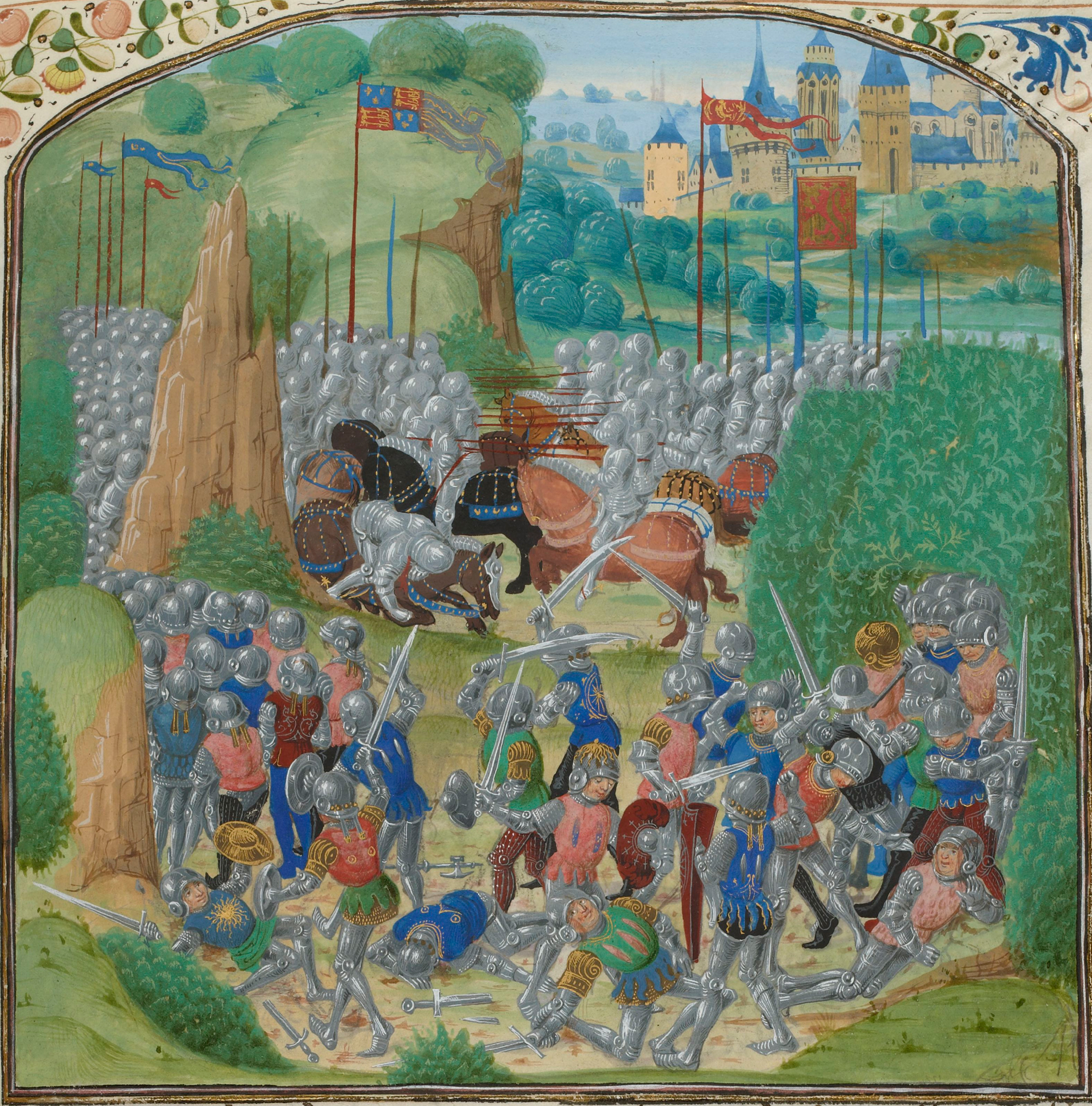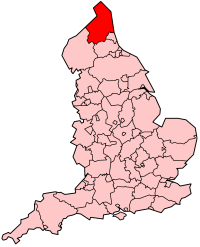|
Newminster Abbey
Newminster Abbey was a Cistercian abbey in Northumberland in the north of England. The site is protected by Grade II listed building and Scheduled Ancient Monument status. Ranulph de Merlay, lord of Morpeth, and his wife, Juliana, daughter of Gospatric II, Earl of Lothian, founded the abbey in 1137 and Saint Robert of Newminster from the Cistercian Fountains Abbey was appointed as the first abbot; he governed from 1138 to 1159. The year after its foundation, the abbey (at that time only a group of timber buildings) was burned in an attack by Scottish raiders. The Abbey construction resumed and in 1159 Abbot Robert died and was buried beneath the high altar. His tomb became a shrine and place of pilgrimage, and a number of miracles were ascribed to him so that eventually he was canonised. The abbey was located a short distance to the west of Morpeth, Northumberland, on the boundary between the lands of Ranulph de Merlay and Bertram of Mitford. Both these minor barons, and al ... [...More Info...] [...Related Items...] OR: [Wikipedia] [Google] [Baidu] |
Robert De Umfraville
Sir Robert de Umfraville KG, Lord of Redesdale ( 1363 – 1437) was a knight in late-medieval England who took part in the later stages of the Hundred Years' War, particularly against Scotland. The de Umfraville family had been influential in northeast England for centuries and also held major estates in Yorkshire. His ancestors were mormaers of Angus, and his nephew married into the Percies, a powerful local marcher family with whom de Umfraville was closely associated. Much of Sir Robert's career continued on the same path as his ancestors, being primarily focused on defending the border with Scotland, which had been in a state of near-permanent warfare since the late thirteenth century. Robert de Umfraville fought under three English kings. Beginning his career under Richard II, he probably fought at the Battle of Otterburn with Henry "Hotspur" Percy in 1388. After Richard was deposed by Henry IV in 1399, de Umfraville loyally served the new Lancastrian regime, waging ... [...More Info...] [...Related Items...] OR: [Wikipedia] [Google] [Baidu] |
Newminster Abbey 3 - Geograph , Roman Catholic Saint
{{disambiguation ...
Newminster may refer to *Newminster (horse), the 1851 St. Leger winning racehorse *New Minster, Winchester *Newminster Abbey, Northumberland, United Kingdom * a British tanker in service 1952-54 *Robert of Newminster Robert of Newminster ( c. 1100–1159) was a priest, abbot, and a saint of the Catholic Church. He was born in Gargrave in Yorkshire, England. He was one of the monks who founded Fountains Abbey and is named from the abbey he founded in Mo ... [...More Info...] [...Related Items...] OR: [Wikipedia] [Google] [Baidu] |
Brandling Of Newcastle
The Brandlings of Newcastle were a wealthy family of merchants and land and coal owners in Newcastle upon Tyne and Northumberland. Tudor and Stuart periods Sir John Brandling, who was knighted at Blackheath in 1497 and married Elizabeth Helye of Northumberland, settled in Newcastle where he served as sheriff in 1505, and as mayor in 1509, 1512, 1516 and 1520. His son, Sir Robert Brandling (died 1568), served as sheriff of Newcastle in 1524 and also as mayor in 1536, 1543, 1547 and 1564. In 1547, whilst mayor, he was knighted by Edward Seymour, 1st Duke of Somerset, following the Battle of Pinkie Cleugh, in Scotland. He was Custos Rotulorum of Northumberland. Another son, Henry Brandling (1515–1578), was Sheriff of Newcastle in 1566 and mayor of the city in 1568, 1575 and 1576. His brother Thomas Brandling (1512–1590) was educated at the newly established Royal Grammar School, and founded the land and coal owning dynasty. Robert Brandling (15751636) sat in the House o ... [...More Info...] [...Related Items...] OR: [Wikipedia] [Google] [Baidu] |
History Of Northumberland
Northumberland, England's northernmost county, is a land where Roman occupiers once guarded a walled frontier, Anglian invaders fought with Celtic natives, and Norman lords built castles to suppress rebellion and defend a contested border with Scotland. The present-day county is a vestige of an independent kingdom that once stretched from Edinburgh to the Humber, hence its name, meaning literally 'north of the Humber'. Reflecting its tumultuous past, Northumberland has more castles than any other county in England, and the greatest number of recognised battle sites. Once an economically important region that supplied much of the coal that powered the industrial revolution, Northumberland is now a primarily rural county with a small and gradually shrinking population. Prehistory As attested by many instances of rock art, the Northumberland region has a rich prehistory. Archeologists have studied a Mesolithic structure at Howick, which dates to 7500 BC and was identified as B ... [...More Info...] [...Related Items...] OR: [Wikipedia] [Google] [Baidu] |
Cistercian Monasteries In England
The Cistercians, () officially the Order of Cistercians ( la, (Sacer) Ordo Cisterciensis, abbreviated as OCist or SOCist), are a Catholic religious order of monks and nuns that branched off from the Benedictines and follow the Rule of Saint Benedict, as well as the contributions of the highly-influential Saint Bernard of Clairvaux, known as the Latin Rule. They are also known as Bernardines, after Saint Bernard himself, or as White Monks, in reference to the colour of the "cuculla" or cowl (choir robe) worn by the Cistercians over their habits, as opposed to the black cowl worn by Benedictines. The term ''Cistercian'' derives from ''Cistercium,'' the Latin name for the locale of Cîteaux, near Dijon in eastern France. It was here that a group of Benedictine monks from the monastery of Molesme founded Cîteaux Abbey in 1098, with the goal of following more closely the Rule of Saint Benedict. The best known of them were Robert of Molesme, Alberic of Cîteaux and the English ... [...More Info...] [...Related Items...] OR: [Wikipedia] [Google] [Baidu] |
Religious Organizations Established In The 1130s
Religion is usually defined as a social- cultural system of designated behaviors and practices, morals, beliefs, worldviews, texts, sanctified places, prophecies, ethics, or organizations, that generally relates humanity to supernatural, transcendental, and spiritual elements; however, there is no scholarly consensus over what precisely constitutes a religion. Different religions may or may not contain various elements ranging from the divine, sacred things, faith,Tillich, P. (1957) ''Dynamics of faith''. Harper Perennial; (p. 1). a supernatural being or supernatural beings or "some sort of ultimacy and transcendence that will provide norms and power for the rest of life". Religious practices may include rituals, sermons, commemoration or veneration (of deities or saints), sacrifices, festivals, feasts, trances, initiations, funerary services, matrimonial services, meditation, prayer, music, art, dance, public service, or other aspects of human culture. Religio ... [...More Info...] [...Related Items...] OR: [Wikipedia] [Google] [Baidu] |
Township (England)
In England, a township (Latin: ''villa'') is a local division or district of a large parish containing a village or small town usually having its own church. A township may or may not be coterminous with a chapelry, manorialism, manor, or any other minor area of local administration. The township is distinguished from the following: *Vill: traditionally, among legal historians, a ''vill'' referred to the tract of land of a rural community, whereas ''township'' was used when referring to the tax and legal administration of that community. *Chapelry: the 'parish' of a chapel (a church without full parochial functions). *Tithing (country subdivision), Tithing: the basic unit of the medieval Frankpledge system. 'Township' is, however, sometimes used loosely for any of the above. History In many areas of England, the basic unit of civil administration was the parish, generally identical with the Parish#Ecclesiastical parish, ecclesiastical parish. However, in some cases, particularly ... [...More Info...] [...Related Items...] OR: [Wikipedia] [Google] [Baidu] |
A Vision Of Britain Through Time
The Great Britain Historical GIS (or GBHGIS) is a Spatial Database, spatially enabled database that documents and visualises the changing human geography of the British Isles, although is primarily focussed on the subdivisions of the United Kingdom mainly over the 200 years since the first Census Act 1800, census in 1801. The project is currently based at the University of Portsmouth, and is the provider of the website ''A Vision of Britain through Time''. NB: A "GIS" is a geographic information system, which combines map information with statistical analysis, statistical data to produce a visual picture of the iterations or popularity of a particular set of statistics, overlaid on a map of the geographic area of interest. Original GB Historical GIS (1994–99) The first version of the GB Historical GIS was developed at Queen Mary, University of London between 1994 and 1999, although it was originally conceived simply as a mapping extension to the existing Labour Markets Database ... [...More Info...] [...Related Items...] OR: [Wikipedia] [Google] [Baidu] |
Civil Parish
In England, a civil parish is a type of Parish (administrative division), administrative parish used for Local government in England, local government. It is a territorial designation which is the lowest tier of local government below districts of England, districts and metropolitan and non-metropolitan counties of England, counties, or their combined form, the Unitary authorities of England, unitary authority. Civil parishes can trace their origin to the ancient system of Parish (Church of England), ecclesiastical parishes, which historically played a role in both secular and religious administration. Civil and religious parishes were formally differentiated in the 19th century and are now entirely separate. Civil parishes in their modern form came into being through the Local Government Act 1894, which established elected Parish councils in England, parish councils to take on the secular functions of the vestry, parish vestry. A civil parish can range in size from a sparsely ... [...More Info...] [...Related Items...] OR: [Wikipedia] [Google] [Baidu] |
Ralph De Greystoke, 3rd Baron Greystoke
Ralph de Greystoke, 3rd Baron Greystoke, (18 October 1353 – 6 April 1418) was an English peer and landowner. Life Greystoke was the son of William de Greystoke, 2nd Baron Greystoke, and Joane, daughter of Lord Fitzhugh, his second wife. He was born on 18 October 1353 at Ravensworth Castle, North Yorkshire, the home of his maternal uncle Henry. As he was still a child when his father died, his estates were placed under the guardianship of Roger de Clifford, 5th Baron de Clifford. He was summoned to Parliament between 28 November 1375 and 5 October 1417, and, in the 1370s and 1380s, served as a warden of the Scottish Marches. In 1384, he led an English force that was defeated by the Scots, under the command of George I, Earl of March, while they were travelling to Roxburgh. Greystoke was captured and taken to Dunbar Castle, where he was provided with a meal in the great hall, served upon his own dining-ware, which had been seized from his baggage train along with han ... [...More Info...] [...Related Items...] OR: [Wikipedia] [Google] [Baidu] |
Robert De Umfraville, Earl Of Angus
Robert de Umfraville, 8th Earl of Angus, of Prudhoe, Chollerton, Harbottle, and Whelpington, Northumberland ( 1277 – 1325) was an Anglo-Norman baron in Northumberland and the eighth Earl of Angus. Life Robert was the second son of Gilbert de Umfraville and Elizabeth Comyn, daughter of Alexander Comyn, Earl of Buchan. Umfraville was more than thirty years old at his father's death. Umfraville adhered to King Edward II of England both against Scots and barons, and was regularly summoned to the English parliaments as Earl of Angus (although in name only- the title had ceased to have any meaning whatsoever since the outbreak of the 1296 First War of Scottish Independence). He was summoned to the coronation of King Edward II of England in February 1308. He was Joint Lieutenant and Guardian of Scotland from 21 June 1308, and appointed to treat for peace with the Scots on numerous occasions. He fought at the Battle of Bannockburn, and was taken prisoner after the battle by Robert ... [...More Info...] [...Related Items...] OR: [Wikipedia] [Google] [Baidu] |





